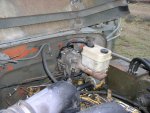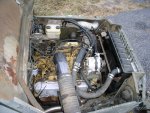spicergear
New member
- 2,307
- 26
- 0
- Location
- Millerstown, PA
Jake, I found a very good detailed pdf format of the Hydro-Max from, I think, Bosch. I would not run anything else after mine as it wasn't that way from factory. I would find one specifically set up like that or, which may happen, run another pump for PS like what seemed to be pretty standard on the medium duty trucks.
I simplified the braking circuit by 'commonizing' the lines. Basically brought both lines from the master cylinder down to the frame rail then brought them into a 'T' fitting. I brought them down in 1/4" line to a 1/4" 'T' fitting with a 5/16" adapter on the outlet. I even bored out the fitting a couple of drill sizes to propagate flow. I then ran a 5/16 line from there back to the 'T' fitting where the original brake line tees into the main brakes for the truck. There is no split circuit anymore. The split circuit would not work with this set up as its way uneven having 50% more needed for the rear than front. The front would make it's line pressure and apply the brakes firmly while the rear was still low pressure having to feed twice the amount of wheel cylinders. I know this as fact as I originally tried a hydroboost unit and had the brakes split.
Having the circuits commonized into one larger outlet line made this set up work as good as it possibly can. It WILL deliver all the braking power the truck needs, and obviously more by the GVW rating, and by running back into the single line it doesn't get into any proportioning whoa's or other components to complicate the system.
Parts I ended up using for this:
1) New Saginaw PS pump for '93 1 ton Chevy with Medium Duty pump's spring, pressure cartridge, and outlet fitting-
1) Ebay'ed PS pump mounts for Big Block Chevy modified to fit my CAT-
1) Ebay'ed two groove PS pump pulley-
1) Used Medium Duty high pressure line w/ new end swaged on for different formed hard line and fitting-
1) Used Hydro-Max booster and 50.80mm MC from 1997 S1700 International-
1) Hanging pedal assembly from same International, only used brake pedal-
1) 2' section of new 1/2" Gas and Oil hose for return line-
2) Sections of 3/8" PS hose used for returns from pictured fitting to pump's reservoir-
2) 3' pieces of 1/4" brake line-
1) 1/4" brass brake 'T'-
1) 5' piece os 5/16 brake line-
1) 5/16" adapter fitting-
I simplified the braking circuit by 'commonizing' the lines. Basically brought both lines from the master cylinder down to the frame rail then brought them into a 'T' fitting. I brought them down in 1/4" line to a 1/4" 'T' fitting with a 5/16" adapter on the outlet. I even bored out the fitting a couple of drill sizes to propagate flow. I then ran a 5/16 line from there back to the 'T' fitting where the original brake line tees into the main brakes for the truck. There is no split circuit anymore. The split circuit would not work with this set up as its way uneven having 50% more needed for the rear than front. The front would make it's line pressure and apply the brakes firmly while the rear was still low pressure having to feed twice the amount of wheel cylinders. I know this as fact as I originally tried a hydroboost unit and had the brakes split.
Having the circuits commonized into one larger outlet line made this set up work as good as it possibly can. It WILL deliver all the braking power the truck needs, and obviously more by the GVW rating, and by running back into the single line it doesn't get into any proportioning whoa's or other components to complicate the system.
Parts I ended up using for this:
1) New Saginaw PS pump for '93 1 ton Chevy with Medium Duty pump's spring, pressure cartridge, and outlet fitting-
1) Ebay'ed PS pump mounts for Big Block Chevy modified to fit my CAT-
1) Ebay'ed two groove PS pump pulley-
1) Used Medium Duty high pressure line w/ new end swaged on for different formed hard line and fitting-
1) Used Hydro-Max booster and 50.80mm MC from 1997 S1700 International-
1) Hanging pedal assembly from same International, only used brake pedal-
1) 2' section of new 1/2" Gas and Oil hose for return line-
2) Sections of 3/8" PS hose used for returns from pictured fitting to pump's reservoir-
2) 3' pieces of 1/4" brake line-
1) 1/4" brass brake 'T'-
1) 5' piece os 5/16 brake line-
1) 5/16" adapter fitting-




